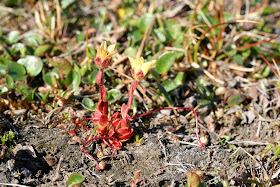Saxifraga flagellaris (S. platysepala) occurs scattered throughout the high arctic region. On Spitsbergen (where it was seen and photographed here in Adventdalen) it is found locally on exposed polygonised Cassiope/Dryas tundra heath where vegetative competition is very moderate. Other species of saxifrage are often found growing with it including S. cespitosa, S. hieraciafolia, S. hirculus and S. oppositifolia. Pedicularis hirsuta, Potentilla hyparctica, Salix polaris, Silene acaulis and Silene uralensis, other specialised high arctic species, occur there also.
.jpg)
Saxifraga flagellaris has an unusual method of reproduction in that it produces incipient rosettes which are initially attached to the parent plant by long thin runners (rather like strawberry plants). These blow about (flagellate, hence the scientific name) in the wind and eventually become detached, some of them rooting nearby. These then produce the new generation. This strategy has evolved in order to overcome difficulties in achieving reproduction by pollination in the very short growing/flowering season.
.jpg)
.jpg)
.jpg)
Above, the small rosettes can be seen.
Below, the open slope where the saxifrage occurs is onthe extreme left from the lake. The characteristic structure of the polygonised tundra (caused by alternating freeze/thaw cycles) where the plants grew can be seen (bottom).
.jpg)
.jpg)
No comments:
Post a Comment